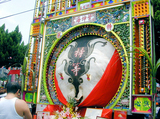<Update: October 5, 2010 >I just noticed a surge of visitors to this post, so I thought I’d add a link to a Flickr photo set I took of the god pig sacrifice at a small temple next to the apartment where I was living in Taipei at the time.
http://www.flickr.com/photos/mutantfrog/sets/817964/
Doesn’t that sound like the title of a pulp story or B movie?
The Ghost Month is nearing it’s end here in Taiwan, and all through the past few weeks festivals and offerings have been visible in temples and shrines and in front of homes and businesses throughout Taipei. While most people reading this may know that Chinese religion involves the offering of food, drink, and burned fake paper money (which looks nothing like real money) to ancestor and god spirits, the continues existence of ritual animal sacrifice may surprise some.
Danny Bloom had a short post on Japundit about two weeks ago, the day after I saw my first pig offering at a small corner temple I pass everyday on the way to class.
Taiwan’s Hakka ethnic group holds an annual festival during the seventh lunar month, where a unique custom of sacrificing “spirit pigs,” which are traditionally grown to a huge size — and we mean HUGE — before being slaughtered.
However, in keeping with the principles of the ethical treatment of animals, today’s ceremonies often use likenesses of pigs instead of the real thing.
In this photo from the Taipei Times, a sculpture of a ‘divine pig’ can be seen outside Taipei City Hall, where the annual Taipei Hakka Memorial Ceremony was taking place recently.
Oink!
The August 13th Taipei Times had a rather hilarious photo of a pig stand-in made out of fruits.
They also have two interesting articles about the tradition of pig sacrifice in Taiwan.
Sacrificial swine prompt backlash
The belief that “the bigger the sacrificed pig, the more luck a person will have for the rest of the year” has resulted in a lifetime of agony for hundreds of pigs, bred by farmers to become abnormally overweight before slaughter, animal-rights activists said yesterday.
Dozens of activists from several animal-rights groups yesterday gathered in front of the Council of Agriculture (COA) to protest traditional pig contests, saying the government has failed to regulate abusive practices toward animals.Showing a documentary about pigs selected for the contest, activists said that 15 to 18 months before the overweight pigs are killed as sacrificial offerings, they are deprived of fluids, exercise and even turning over freely. The pigs undergo these cruel farming practices until their weight reaches upwards of five to six times their normal weight, activists said.
The accompanying photo truly must be seen to be believed. Yes, those are the pig’s ears at the bottom.
Three days ago the same publication had a good article giving a roundup of various traditions of the Ghost Festival. Of interst here is the final anecdote, concerning a rural pig farmer who raises animals for sacrifice, which gives a much more accepting description of the practice than the earlier story focusing on animal rights protesters.
About 10km away from the Yonglian Temple, a different type of religious tradition is taking place. The Ghost Festival had attracted about a dozen pig farmers carrying truckloads of sacrificial pigs to the Tachong Temple in Pali (八里) Township, Taipei County, one of three local temples taking turns to host the annual event.
The 210-year-old Tachong Temple has just been designated as having historically significant architecture, and temple managers hope to begin a renovation project by the end of next month to give the building a face-lift.
Chou Chin-tiao (周金條) won this year’s pig-raising contest with an animal that weighed 890kg. The first runner-up came in far behind, at under 500kg, with the second runner-up weighing about 400kg.
This was the fifth time Chou won the contest. The secret of growing such a big pig, Chou said, lies in the fodder. The feed he uses contains grain shells, rice porridge, canned fish, pig oil, milk powder and raw oysters.
The animal is fed twice a day, with 14kg of fodder each meal, and is given water every three hours. The cost for the fodder alone is about NT$30,000 a month.
During the summer, he has seven fans blowing on the animal to keep it cool and comfortable.
During his some 30 years of pig farming, Chou said that only three pigs died under his care. Although he spends more time and effort taking care of the animals than his wife and four children, Chou said that it pays off when he wins the highest honor.
“I don’t raise the pigs for the gold plate or certificate of merit,” he said. “I do it to fulfill a promise I made to the Buddha when I was poor that I would offer big sacrifices if I could have food to eat and clothes to wear.”



 The Zimmerli Art Museum, located on the campus of my alma mater, Rutgers University, has a well put together
The Zimmerli Art Museum, located on the campus of my alma mater, Rutgers University, has a well put together 




